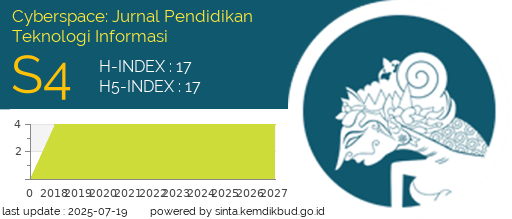ANALYSIS OF LAND SURFACE TEMPERATURE IN THE KRUENG ACEH WATERSHED USING GOOGLE EARTH ENGINE
DOI:
https://doi.org/10.22373/cj.v9i1.29076Abstract
The constantly changing land surface temperature has implications for agricultural productivity and human health, therefore it is important to observe the land surface temperature to provide information about the characteristics and patterns of a region. The purpose of this research is to determine the changes and spatial patterns of land surface temperature distribution in the Krueng Aceh Watershed in 2013, 2018, and 2023. The method employed in this study involves utilizing the Google Earth Engine platform and MODIS imagery. Land surface temperature data from MODIS imagery is processed using JavaScript programming language, and the results are analyzed to obtain the distribution of land surface temperature. The study results indicate that the land surface temperature in the Krueng Aceh Watershed was 29,11℃ in 2013, increase to 29,5℃ in 2018, and then decreased to 29,19℃ in 2023. The Krueng Aceh Watershed in 2013, 2018, and 2023 exhibits similar spatial patterns and distributions of land surface temperature, with areas in Banda Aceh City experiencing higher temperatures compared to those in Aceh Besar District, which exhibit varying temperatures.
References
A. K. Taloor, D. S. Manhas, & G. C. Kothyari, “Retrieval of Land Surface Temperature, Normalized Difference Moisture Index, Normalized Difference Water Index of The Ravi Basin Using Landsat Data,” Applied Computing and Geosciences, vol. 9, March. 2021.
P. C. Latue, H. Rakuasa, G. Somae, & A. Muin, “Analisis Perubahan Suhu Permukaan Daratan di Kabupaten Seram Bagian Barat Menggunakan Platform Berbasis Cloud Google Earth Engine,” Sudo Jurnal Teknik Informatika, vol. 2, no. 2, pp. 45-51, May. 2023.
H. Rakuasa, & M. A. Lasaiba, “Analisis Suhu Permukaan Daratan di Kabupaten Buru Menggunakan Data Citra Satelit MODIS Berbasis Cloud Computing Google Earth Engine,” GEOFORUM Jurnal Geografi dan Pendidikan Feografi, vol. 2, no. 2, pp. 71-80, December. 2023.
H. Rakuasa, & S. Pertuack, “Pola Perubahan Suhu Permukaan Daratan di Kecamatan Ternate Tengah, Kota Ternate Tahun 2013 dan 2023 Menggunakan Google Earth Engine,” Sudo Jurnal Teknik Informatika, vol. 2, no. 2, pp. 78-85, June. 2023.
D. Darwin, S. Syahrul, & H. Basri, “Analisis Karakteristik Hidrologi DAS Krueng Aceh, Provinsi Aceh (Studi Kasus Sub DAS Krueng Jreu dan Sub DAS Krueng Khea),” Rona Teknik Pertanian, vol. 14, no. 1, pp. 58-72, April. 2021.
T. Ferijal, M. Mustafril, & D. S. Jayanti, “Dampak Perubahan Iklim Terhadap Debit Andalan Sungai Krueng Aceh,” Rona Teknik Pertanian, vol. 9, no. 1, pp. 50-61, April. 2016.
N. E. Safitri, T. Ferijal, & S. Syahrul, “Perubahan Iklim Di DAS Krueng Aceh,” Jurnal Ilmiah Mahasiswa Pertanian, vol. 8, no. 1, pp. 296-300, February. 2023.
R. Rahmayanti. “Dampak Perubahan Lahan pada DAS Krueng Aceh terhadap Neraca Air Menggunakan Metode Thornthwaite Mather,” B.T Thesis, Department of Enviromental Engineering, Faculty of Science and Engineering, Universitas Islam Negeri Ar-Raniry, Indonesia, 2023.
L. M. Prayogo, “Platform google earth engine untuk pemetaan suhu permukaan daratan dari data series modis,” DoubleClick: Journal of Computer and Information Technology, vol. 5, no. 1, pp. 25-31, Agustus. 2021.
F. S. Hehanussa, D. R. S. Sumunar, & H. Rakuasa, “Pemanfaatan Google Earth Engine Untuk Identifikasi Perubahan Suhu Permukaan Daratan Kabupaten Buru Selatan Berbasis Cloud Computing,” Gudang Jurnal Multidisiplin Ilmu, vol. 1, no. 1, pp. 37-45, July. 2023.
S. S. Rijal, Mengolah Citra Pengindraan Jauh Dengan Google Earth Engine, Deepublish, Yogyakarta, p.7, 2020.
O. Mutanga, & L. Kumar, “Google Earth Engine Applications,” Remote sensing, vol. 11, no. 5, pp. 591, March. 2019.
K. A. D. Sukowati, “Pemanfaatan Data Modis untuk Mengukur Suhu Permukaan Bumi dalam Rangka Pemantauan Pemanasan Global,” B.T Thesis, Department of Electrical Engineering, Faculty of Engineering, Universitas Indonesia, Indonesia, 2009.
Mujiono, Buku Ajar Pengindraan Jauh untuk Pertanian, Elmarkazi, Bengkulu, p.7, 2019.
Downloads
Additional Files
Published
Issue
Section
License
Authors who publish with Cyberspace Journal agree to the following terms:
- Authors retain copyright and grant the journal right of first publication with the work simultaneously licensed under a Creative Commons Attribution License that allows others to share the work with an acknowledgement of the work's authorship and initial publication in this journal.
- Authors are able to enter into separate, additional contractual arrangements for the non-exclusive distribution of the journal's published version of the work (e.g., post it to an institutional repository or publish it in a book), with an acknowledgement of its initial publication in this journal.
- Authors are permitted and encouraged to post their work online (e.g., in institutional repositories or on their website) prior to and during the submission process, as it can lead to productive exchanges, as well as earlier and greater citation of published work (See The Effect of Open Access).


















